
|   |

|   |
Kochi-Muziris Biennale: India’s first Biennale - Padma Jayaraj e-mail: padmajayaraj@gmail.com January 6, 2013 The word ‘biennale’ means every two years, popularized by the world’s first Venice art fair in 1895. India’s first Biennale from Dec 12, 2012 to March 13, 2013, spread over the quaint town of Fort Kochi, is a dream come true for the art and culture fraternity. Biennale has become part of life, life styles and culture, ever since its inception. The Kochi-Muziris Biennale is contemporary in its quality, yet harks back to ancient history, in its association with Muziris and the colonial past that still lingers in Kochi. The ancient port city of Muziris had witnessed mercantile trade in its international harbor with Greece, Rome, China, Arab and Jewish world, until time and tide shifted its venue to Kochi. History was made during the flood of 1341 AD, when the river Periyar changed its course, silting over the city of Muziris. Ever since, Kochi opened its natural gateway welcoming myriad cultures from across the seas and mountains for many centuries. Jews were living here when St Thomas landed. The Chinese fishing nets are dotted on the coastline still in working condition. Islam came before the colonial powers established their sway. The Kochi-Muziris Biennale connects the remnants of its past with the contemporary world bringing together incredibly diverse works of artists from all over the world. It is a gigantic show window for the best of art at the moment, inviting you to a sensory and intellectual voyage whose port of arrival is still unknown. It is experiencing international artistic dialogue that matters. Biennale’s impact on the evolution of Indian art and thinking is a promise for the future. The inaugural ceremony displayed the traditional performances of Kerala, its rhythmic heartbeat in its ethnic percussions. The evenings for the entire three months are going to be colorful with cultural programs like Nangiarkoothu, Kathakali, Ottam Thullal, Melam, Thayambaka, Mizhavu, Ghazal nights, and band performances. The cultural segment of the Kochi-Muziris Biennale was inaugurated by eminent theater personality Sanjana Kapoor. The program is to reintroduce theatre sketches that were perfected in ‘Roots,’ Thrissur, by late Jose Chiramel. ‘Annual Rings’ kicked off the Biennale. It was a literary event in which writers, NS Madhavan and Sethu, whose works echo life of Kochi in its moorings, were honored. 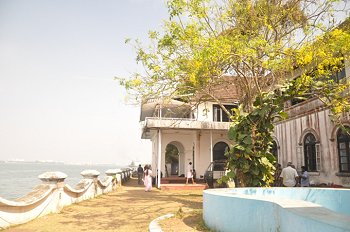 Aspinwall House (1867) In the many venues spread over a vast area, 90 artists from 24 countries are to present installation art, videos, sculptures and paintings to engage historical, social, political and cultural issues. In the process Fort Kochi is to be Art Kochi, putting India on the global art map. Aspinwall House (1867), a large sea facing heritage property that traded in spice, is a primary venue where many installations are showcased in its huge space. It hosts many artist-led projects and events. The ancient history of the place reverberates in Vivan Sundaram’s installation. 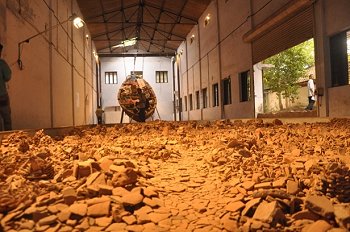 The city of ruins ‘The city of ruins’ is built by shards of terracotta pieces from the excavated site of Muziris. It is the perfect foreground for a boat on sail. Filled with household goods of families in flight, Prasad Raghavan narrates the poignant tale of man’s search for home all through human history. It evokes the tale of refugees since Noah’s ark to our own times, displaced for reasons that are natural and man-made. You watch the ship nearby that carries spices known to the coast of Kerala. It ranges from pepper - ‘the black gold’ - to plantation crops like tea and coffee. Later in the evening, we drove through the spice market that has been the trading street for centuries. In the embalmed darkness, as I inhaled the aroma of spices, for a moment I lost sense of the present and felt as if I had wandered through the same spots, through the same street in my previous human incarnations. Such are the magical moments that art creates. Dylan Martorell from Scotland is involved in an ongoing project of sound tracks that explores personal journeys. Inspired by street-based examples of nomadic activities, homeless shelters, garbage collectors etc. the artist creates objects of art from thrown away pieces. Here the sound installation displays a wonderland of music. The same beat on different mediums: on a drum, on tiles made of pottery, ceramic, crockery, and metal. Krishna with his flute, pouring unheard melody, a symbolic icon that lifts the installation to philosophical heights. In the background we see paintings of Buddhist monks making musical instruments. Another room houses a spice speaker sound system which generates specific clouds of spice making the music synaesthetic. Another musical installation is like a temple. You enter barefoot and as you touch the objects on display each produces a unique note. It is reverence that should emanate. But, the excited crowd touching everything produces a cacophony, the price we pay for our ignorance and irreverence. 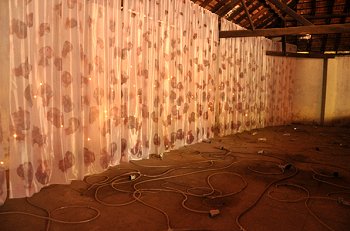 Dutty Water Wangechi Mutu, Kenyan born New York based artist believes, “Females carry the marks, language and nuances of culture.” Her installation ‘Dutty Water’ is a vehicle that carries the aesthetics of dirty versus purity from a feminist perspective. On the floor is spread translucent tubes that remind you of the innards of the female, punctuated by footwear of the woman. The curtain on the wall carry abstracts that recall fetus in the womb. But lights twinkle in the morbid backdrop, like stars in the dark. Does the installation mark the footprints left on the sands of time by the female principle in creation? 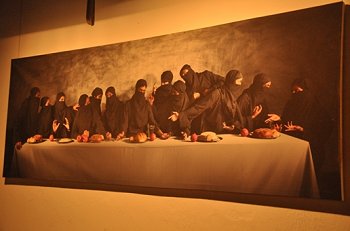 Last Supper Vivek Vilasini from Thrissur, Kerala, showcases an alternative to ‘Last Supper,’ the same cast but women in purdha whose mouths are closed. The same number thirteen with the Messiah in the centre with a glass of wine, loaf of bread, symbols of sacrament, and fruits as in the original suggestive of the possibility of an alternative vision, mission and religion with its own world view. But alas… it is suppressed and silenced. Pepper House is the venue where Sudarsan Shetty has built his project. Sudarsan Shetty is noted for his sculptural installations. Here it is concerned with archeological excavations that redefine histories. His installation reminds one of Troy. And the symbolic House of the Soul point to many dimensions of his art. Indian artist Atul Dodiya, a known painter, is exhibiting his photographs breaking the traditional mould, in tune with the spirit of the Biennale. An open pavilion with numerous flags fluttering is waiting for the Third Edition of the New World Summit to be held in March 2013. Representatives of the many ‘banned organizations’ by the Indian Government will present the histories of their organizations, their political struggles, results gained as well as debate with each other and with audience. These flags tell a history of democratic India from the point of view of resistance, yet to be told. 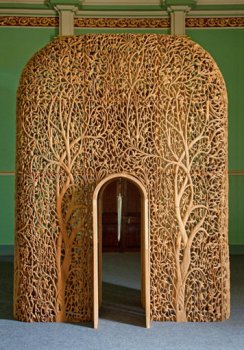 House of the Soul David Hall, Durbar Hall, Cochin Club, Parade ground, Calvathi Canal Deck, Dutch Warehouse, Kashi Art Gallery, Jew Town Road Godown, Blue House, and Mattanchery Bazar Road are other places that shape the contours of the Kochi-Muziris Biennale for the three months of the art fiesta.  Higher Education Project offers an outreach centre for students and faculty from educational institutions cutting across India to interact and explore contemporary art practices and ideas where they will come up with a site specific exhibition of their own. Indian and international artists are exhibiting their artworks. The variety of mediums is astounding: film, installation, painting, sculpture, new media and performance art. The Kochi-Muziris Biennale is an ongoing project beckoning you. For three months its doors are wide open. And all paths of the art world lead to Kochi via land, sea and air. The amalgamation of various art forms and artists, futuristic in expressions, transcends all mediums of creativity and makes the Biennale the melting pot of art – a must visit for art connoisseurs as well as the dormant artist in you. Padma Jayaraj is a freelance writer on the arts and travel. She is a regular contributor to www.narthaki.com |